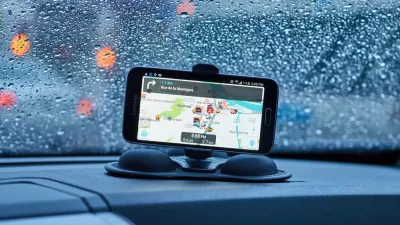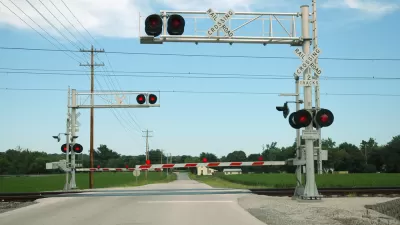The March 28 crash on Metro's extensive light rail system shouldn't have happened. All the safety measures acted as they should have. Could more have been done to prevent the motorist's fateful turn across the tracks as a train approached?
The beginning of the post on Saturday's, high-profile crash on Los Angeles Metro's Expo Line reads, "According to eyewitnesses, a silver Hyundai sedan had turned left onto the tracks, although that has yet to be confirmed." It's been confirmed, although it is still under investigation.
Credit: Wikimedia Commons.
All the right precautions were operating correctly to prevent the motorist's ill-fated turn in front of the train as it approached the crossing near University of Southern California (USC) and the Exposition Park Rose Garden [see LA Times image] on Exposition Blvd.
Traffic signals along Exposition Boulevard turned red, and lights flashed to signal the approach of the train...
The Expo Line cars involved in Saturday's crash were wrapped in vivid yellow banners with large lettering reading, "Hear bells?" and "Heads up, watch for trains" — part of a recent public awareness campaign to reduce collisions along portions of the 87-mile Metro rail network.
Still, more can be done, according to Metro critics, including "Najmedin Meshkati, a USC engineering professor who studies rail safety and has criticized the design of crossings along the Expo Line, which links downtown Los Angeles to Culver City and will begin service to Santa Monica sometime next year," writes Nelson.
Brightly colored banners and flashing lights are better than nothing, Meshkati said, but the only way to protect pedestrians and cars from trains is by separating them, either with crossing arms and gates, or train tracks that run under or above traffic.
Metro's response: "But separating tracks from traffic is often cost-prohibitive." Surface-street crossings are safe when drivers and pedestrians follow traffic signals, according to Metro spokesperson Marc Littman, adding "[a]ll over the world, there are trains operating safely in dense, urban areas. You can't build a bubble around the rail system."
Short of doing costly grade separations, [more on that below regarding Metrolink, the commuter rail agency] Meshkati and other academics argue that grade crossing safety can be improved with more comprehensive applications of "gate arms that block off all lanes of traffic in both directions as trains approach," writes Nelson. "So-called four-quadrant arms prevent drivers from maneuvering into the opposite lane and trying to beat the train," adding that "the wide intersection where Saturday's crash occurred does not have gate arms."
Nelson references the deadly Metrolink crash at an Oxnard crossing on Feb. 24 in Ventura County. "A $30-million grade separation planned for the Rice Avenue crossing, which saw three [crashes]* in the five years before February's crash, languished without state and federal funding."
*Nelson used the word "accidents". I substituted it with crashes per Operation Lifesaver's "Highway-Rail Crossing Questions and Answers" See fourth question: "Why can’t I use the word ACCIDENT in my presentation?" [PDF].
Hat tip to Heather Caygle of Politico Morning Transportation.
FULL STORY: Metro light rail crash near USC renews debate on rail safety

Maui's Vacation Rental Debate Turns Ugly
Verbal attacks, misinformation campaigns and fistfights plague a high-stakes debate to convert thousands of vacation rentals into long-term housing.

Planetizen Federal Action Tracker
A weekly monitor of how Trump’s orders and actions are impacting planners and planning in America.

San Francisco Suspends Traffic Calming Amidst Record Deaths
Citing “a challenging fiscal landscape,” the city will cease the program on the heels of 42 traffic deaths, including 24 pedestrians.

Defunct Pittsburgh Power Plant to Become Residential Tower
A decommissioned steam heat plant will be redeveloped into almost 100 affordable housing units.

Trump Prompts Restructuring of Transportation Research Board in “Unprecedented Overreach”
The TRB has eliminated more than half of its committees including those focused on climate, equity, and cities.

Amtrak Rolls Out New Orleans to Alabama “Mardi Gras” Train
The new service will operate morning and evening departures between Mobile and New Orleans.
Urban Design for Planners 1: Software Tools
This six-course series explores essential urban design concepts using open source software and equips planners with the tools they need to participate fully in the urban design process.
Planning for Universal Design
Learn the tools for implementing Universal Design in planning regulations.
Heyer Gruel & Associates PA
JM Goldson LLC
Custer County Colorado
City of Camden Redevelopment Agency
City of Astoria
Transportation Research & Education Center (TREC) at Portland State University
Jefferson Parish Government
Camden Redevelopment Agency
City of Claremont





























